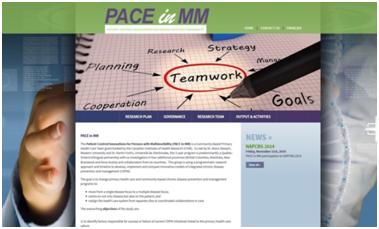By Moira Stewart and Martin Fortin

A Canadian research group led by Drs. Moira Stewart and Martin Fortin recently received funding in the amount of 2.5 million dollars over five years to improve the delivery of primary health care for people with multimorbidity. Awarded by the Canadian Institutes of Health Research (CIHR), this important grant is part of a government initiative to support research on community-based primary health care (CBPHC) across Canada.
Based on a partnership between the respective research teams of Dr. Fortin (Université de Sherbrooke, Québec) and Dr. Moira Stewart (Western University, Ontario), as well as partners from three other Canadian provinces and collaborators from five countries, this group will use a programmatic research approach and timeline to develop, implement and compare innovative models of integrated chronic disease prevention and management (CDPM). The research Team competed with 95 teams from across Canada to obtain this funding. The Team is called “PACE in multimorbidity” for “Patient-Centred Innovations for Persons with Multimorbidity”.
The Team proposes innovations in CDPM that will: reorient care from a single disease focus to a multimorbidity focus; centre on not only disease but also the patient in context; and realign the health care system from separate silos to coordinated collaborations in care. The proposed multifaceted innovations will be grounded in the current realities of CDPM (i.e. chronic care models including self-management programs) that are linked to primary care reform efforts. The Team will build on this firm foundation, will design and test promising innovations and will achieve transformation by creating structures to sustain relationships among researchers, health professionals, patients and decision-makers. The Team will conduct cross-jurisdictional comparisons and is mainly a Quebec – Ontario collaboration with participation from three other provinces: British Columbia, Manitoba and Nova Scotia.
The program will identify factors responsible for the success or failure of current CDPM initiatives linked to the primary care reform, by conducting a realist synthesis of their quantitative and qualitative evaluations and transform consenting CDPM initiatives by aligning them to promising innovations on patient-centred care for multimorbidity patients. The Team will test these new innovations in at least two jurisdictions and compare among jurisdictions. In addition, the program aims to foster the scaling up of innovations and to conduct research on different approaches to scaling up.
The Team’s objectives are based on the concerns expressed by decision-makers and will create new capacity for CBPHC research in Canada by building sustainable networks of interdisciplinary researchers and policy makers, including mentoring junior Team members to build future capacity. The Team is confident that some of the innovations studied over the five years will improve patient self-rated health outcomes while at the same time reduce costs to the system.
Research Team:
Moira A. Stewart, Martin Fortin, Martine Couture, Paul Huras, Onil Bhattacharyya, Antoine Boivin, Judith Brown, Maud-Christine Chouinard, Frances Gallagher, Richard Glazier, William Hogg, Catherine Hudon, Alan Katz, Christine Loignon, Jonathan Sussman, Amardeep Thind, Walter Wodchis, Sabrina Wong, Merrick Zwarenstein, Roxane Borgès Da Silva, Rick Glazier, Fred Burge.
International Advisory Committee
Stewart Mercer (UK), Marjan van den Akker (The Netherlands), John Furler (Australia), Paul Little (UK), Elizabeth A. Bayliss (USA).
Other national collaborators: decision-makers, researchers, collaborators for capacity building and patient advisory committee.
For further information, please do not hesitate to contact Team coordinators: Louisa Bestard Denomme (lbestar@uwo.ca) and Tarek Bouhali (tarek.bouhali@usherbrooke.ca).











